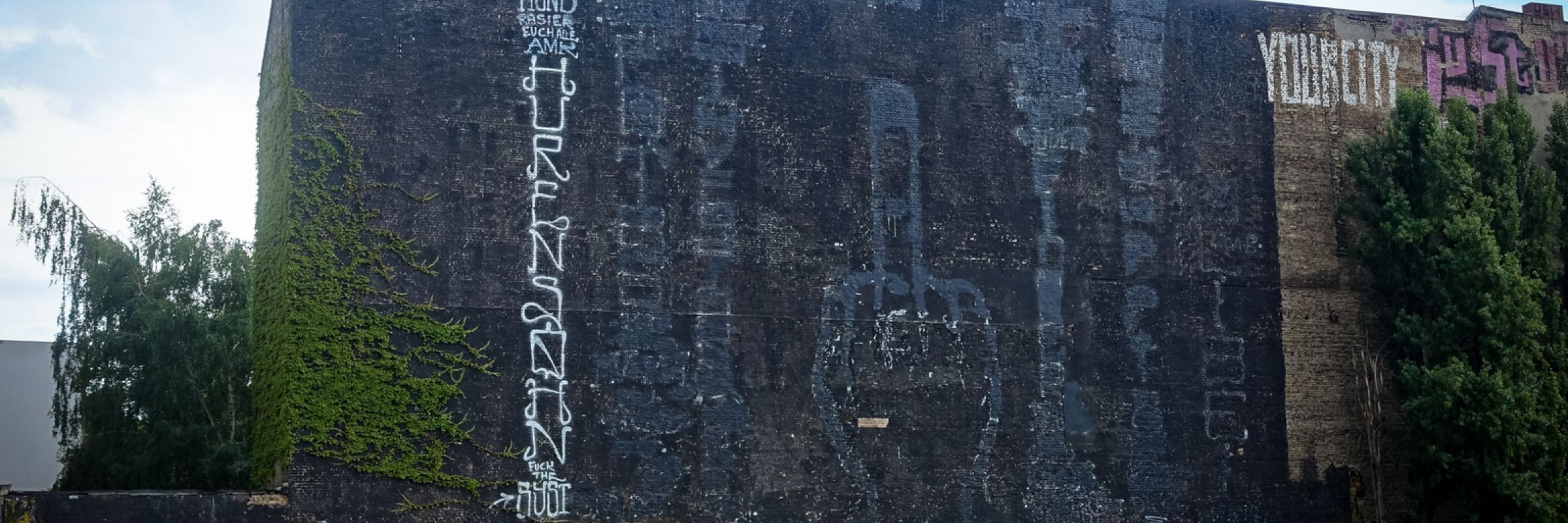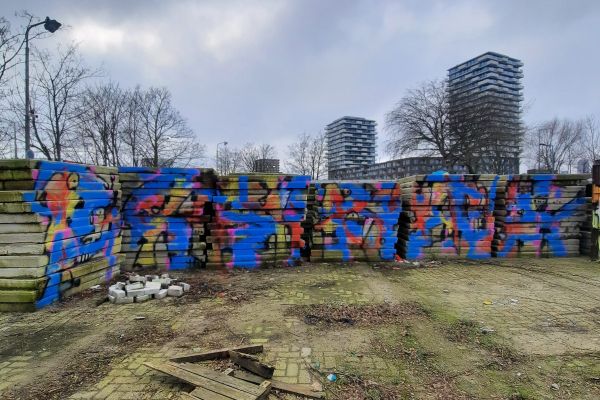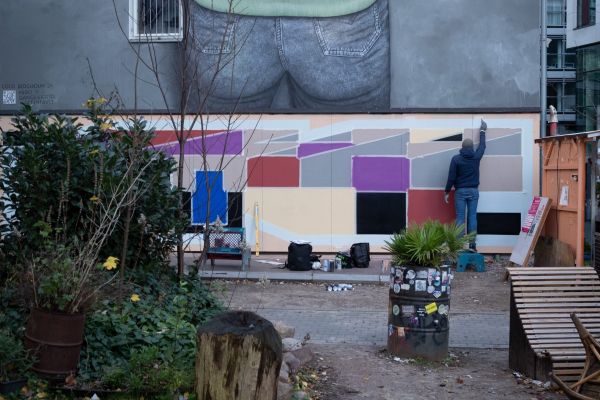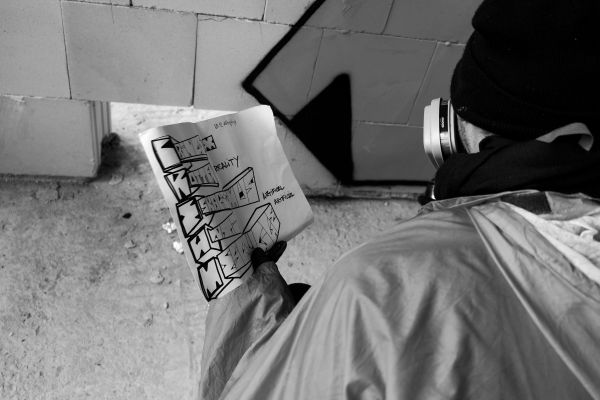Pics! Or it didn’t happen!
As part of the “UrbanArtWeekend” program, we are pleased to contribute to this year’s Berlin art festival “48 Stunden Neukölln”. The theme of the festival is “boom” and due to the current corona crisis “#systemrelevant”. Our video contribution explores the question of whether and to what extent photographic documentation is relevant to street art and graffiti #systemrelevant.
Text – Katja Glaser
Photography – Bart Van Kersavond
Filmedit & FX – Steve Alexander – Rinzen
Voice – Rike Scheffler
Music – Nervousline
Many thanks to Urban Art Week, 48h Neukölln & Katia Hermann!
Photo-Index
00:04 – Swoon, Berlin, Sep 2015
00:06 – Swoon, Berlin, Jan 2007
00:09 – El Bocho & Alias, Berlin, Dec 2006?
00:11 – Just, Berlin, May 2007
00:14 – Kripoe, Berlin, Mar 2007
00:16 – Cream, Berlin, Jun 2007
00:19 – 1up & CBS, Berlin, May 2007
00:22 – Nomad, Berlin, Dec 2006?
00:24 – Nomad, Berlin, Dec 2006?
00:27 – Börek, Berlin, Jun 2007
00:29 – Auszug „Subway Art“, Martha Cooper & Henry Chalfant
01:04 – Martha Cooper Exhibition, Berlin, May 2016
01:08 – Feliz, Marrakech, Oct 2017
01:15 – Momo & Skla, Köln, Mar 2020
01:21 – Caro Pepe, Berlin, Mar 2014
01:28 – Artist Unknown, Bray-Dunes (FR), Dec 2019
01:35 – Cazl, Berlin, Nov 2016
01:46 – Kera, Berlin, Feb 2020
01:50 – Klaas Van Der Linden, Gent, Dec 2018
01:52 – “Berlin: Writing Graffiti”, Brussel, Dec 2019
01:55 – Raws, Berlin, Aug 2016
01:57 – Skenar, Berlin, Aug 2016
02:01 – Berlin, Apr 2015
02:04 – Plotbot Ken, Berlin, Nov 2015
02:07 – Ale Senso, Berlin, Oct 2015
02:10 – Blu, Berlin, Nov 2014
02:24 – Blu, Berlin, Aug 2007
02:33 – Blu, Berlin, Aug 2007
02:44 – Blu, Berlin, Dec 2008
03:11 – Blu, Berlin, Dec 2014
03:21 – Blu, Berlin, Jun 2015
03:29 – Blu, Berlin, Jun 2015
03:38 – Blu, Berlin, May 2016
03:46 – Dotmaster, MB6Streetart Marrakech, Feb 2016
03:51 – Fintan Magee & Karl Addison, Kunstlabor München, May 2019
03:57 – Bosso Fataka, Berlin, Apr 2013
04:06 – Bosso Fataka, Berlin, Mar 2014
04:15 – Bosso Fataka, Berlin, Jul 2015
04:24 – Bosso Fataka, Berlin, Oct 2015
04:32 – Stohead, “Parkhaus Neukölln” Berlin, Apr 2019
04:35 – Tarek Benaoum, “Urban Art Biennale” Völklingen, Jun 2017
04:38 – Isakov, Transurban Köln, Aug 2017
04:41 – Roa, Malmar Fabriek, Jun 2018
05:16 – Roa, Skelet Fabriek, Dec 2018
05:18 – User & Poes, Marrakech, Feb 2019
05:20 – Katre & User, Marrakech, Feb 2019
05:22 – Abdo Mchimich, Agafay Desert Marrakech, Feb 2019
05:36 – Bonom, Brussel, Feb 2017
05:47 – Artist Unknown, Shanghai, Jan 2012
05:59 – XOOOOX, Berlin, Dec 2006?
06:04 – Alias, Klosterfelde – Berlin, Oct 2012
06:07 – Berlin Kidz, Berlin, Aug 2017
06:11 – Nice, Köln, Jan 2019
06:15 – YG, Berlin, Jun 2016
06:19 – Alaniz, Berlin, Jun 2016
06:23 – MakArt, Toulouse, Jun 2019
06:27 – Akim, Berlin, April 2008
06:30 – Kripoe, Istanbul, May 2010
06:33 – 1up, Berlin, Aug 2006
06:36 – Ehso, Berlin, Jun 2007
06:39 – SGS, Berlin, Mar 2007
06:42 – KHC, Berlin, Jun 2007
06:45 – Spair, Berlin, Sep 2006
06:48 – Broa, Berlin, Sep 2006
06:50 – Sam Crew, Berlin, Jul 2007
06:54 – Dolk, Berlin, Jun 2007
06:56 – Emess, Berlin, Apr 2006
06:59 – Sega, Berlin, Sep 2019
07:02 – Kase, Vogelsang – Berlin, Jun 2016
07:05 – Yat, Artbase Festival Neustrelitz, Aug 2019
07:10 – Bird & Nefast & Smok, As (BEL), May 2018
07:16 – Kouka, Jardin Rouge Marrakech, Feb 2016
07:21 – Krito, Jardin Rouge Marrakech, Feb 2015
07:26 – Alias, Artbase Festival Neustrelitz, Sep 2019
07:31 – Plotbot Ken & Artist Unknow, Jan 2015
07:37 – El Bocho, Berlin, Dec 2019
07:42 – Kouka, Jardin Rouge Marrakech, Feb 2019
07:49 – Tick, Berlin, 2019
08:00 – David Mesguich, Marrakech, Jun 2018
08:30 – Katre (360°), Urban Art Biennale Völklingen, Apr 2019
08:40 – Mambo (360°), Urban Art Biennale Völklingen, Apr 2019
08:49 – Tona, Artbase Festival Neustrelitz, Sep 2019
08:55 – Artist Unknown, Wanne-Eickel, May 2019
09:01 – L’Espiegle, Festival des arts de rue de Tameslohte, Mar 2019
09:07 – Loomit, OZM Hamburg, Jan 2018
09:13 – Darco FBI, OZM Hamburg, Jan 2018
09:20 – Guido Van Helten, Oostende, Apr 2017
09:26 – Alaniz, Teufelsberg Berlin, Sep 2017
Pics or it didn’t happen?
For Urban Art, photography is a central medium for presentation, documentation and archiving. It is thus #systemrelevant for both its negotiation as well as for its memory and art historiography.
While today millions of street art and graffiti photos are circulating all over the internet, the early photos of the 1960s, 1970s and 1980s have a canonical status; their authors are celebrated actors and a constitutive part of the street art and graffiti world. One of the most relevant figures here is probably Martha Cooper. Her book “Subway Art”, which she published in 1984 together with the photographer Henry Chalfant, became a milestone in US-American writing documentation and was instrumental in spreading graffiti (through the media) – in Europe and worldwide.
Yet even today, individual urban art photographers prove to be important documentarists and gatekeepers who not only photographically capture art and thus digest it, but also reveal – or at least are able to reveal – new aesthetic potentials through their photographic practices. Even though the medium of the book is far from being obsolete, the majority of these photographers fall back on digital media. Social networks, websites, and blogs enjoy great popularity.
An example of such a blog is “urbanpresents.net”. It features portraits of individual artists, documents lost places, reports on exhibitions and festivals and presents a large number of street art and graffiti photos. Some of the works on display there have been visited for years and thus tell their very own story.
This might be most obvious if you look at the photos of the two Blu murals, which were taken at the Cuvrybrache in Berlin-Kreuzberg and originally in cooperation with JR, at least the right one. This mural shows two masked figures, which – according to a common interpretation – allude to the reconciliation as well as the unmasking of East and West, symbolized by the two hand signals: Eastcoast and Westcoast. The Berlin Wall once ran only a short distance away.
But the fallow land was cleared in September 2014. Due to a fire, but also because it is part of the controversial investor project “Mediaspree”. Only a few months later, in December 2014, the artist countered and had his mural blackened – as an art political statement and in response to a failed urban development policy.
And in June 2015 there was another protest in the same place – this time by Berlin Kidz and Alaniz, who once again commented on the blackened mural, in a daring abseiling action and equipped with a telescopic pole.
In order to capture such a development, photographic documentation is essential: It can show the process of creation of individual works, but also their decay. And what happens in between. When individual works are commented on or supplemented, for example, as was the case with Bosso Fataka’s Strechtlimo, which was installed in spring 2013 as part of the “Urban Art Clash”. Until, two years later, it had weathered or collapsed due to environmental influences.
But not only urban developments and natural weathering processes can be captured by photographic documentation, sometimes artistic developments also become visible – painterly or technical skills, motivic preferences and developments. This is the case, for example, with the Belgian artist ROA. Before he became internationally known, he travelled to many abandoned places to refine his painting style and experiment with colour and surroundings. His favourite place in Belgium was the Malmar factory in Ghent, where he left almost 60 works.
In addition to documenting remote places that are inaccessible to the general public, as here in Marrakech for example, or capturing unusual perspectives, photography can also be used to fight against urban censorship, at least figuratively. Especially in more polemical works, such as those by Bonom in Brussels, the step towards censorship and subsequent buffing is quite obvious. Or in countries that are not democratically organized and enjoy limited artistic freedom, as these photos from Shanghai indicate.
Since photography plays such a central role in the negotiation of street art and graffiti, conversly, the relevance of active photographers increases. They always make decisions in the course of their documentation: They document graffiti and street art, but they also (re)produce it. Here, not only the way of documentation is decisive, but also the choice of motif. Some works are declared worthy of documentation by photographers, others are not. In doing so, they make qualitative value judgements, sometimes unconsciously, sometimes not. Photographers shape the image of the street. What they show and select seems to be the relevant art of the city. To be photographed by one of the central photographers must – from the artist’s point of view – thus always be read as an indirect judgement of quality.
Conversely, however, there is also potential in photographic documentation, often resulting in an additional sensitization when taking photographs. For one thing for the work, for another for its location. Artists like to draw on the know-how and equipment of professional photographers. On the one hand, photos that take into account various formal aesthetic criteria are popular. On the other hand, photos that show artists at work enjoy increasing popularity: during the day in their own studio, or at night, ‘on the run’. These photographic practices nevertheless have a certain exclusivity, since they are based on a mutual trust. Often, these photos overcome the status of pure illustration and create ‘new images’. For they show not only art, but the process of art making and – no less important – the artist himself.
Nevertheless, it must be noted that not only artists are developing, but also photographers. Some of them are now using the latest technical equipment and media, producing spectacular videos and 360-degree, 3D or drone shots, thus expanding the spectrum of what can be documented and archived.
As is symptomatic for graffiti and street art, we are thus dealing – both in terms of art itself and its documentation – with a dynamic field that, at least from a technical/apparatus point of view, is constantly evolving and making use of the new media. This is not surprising, since street art in particular is an art form that has only grown up through digital media and would not be conceivable without it. It is therefore exciting to see what the coming years will bring.
1,099 views
Categories
Tags:






Leave a Reply